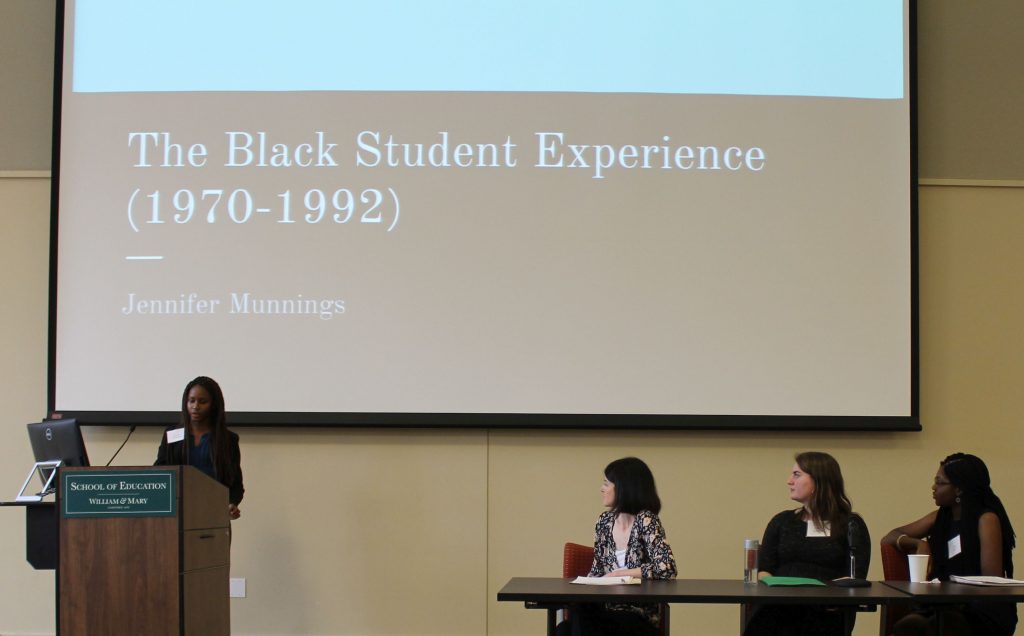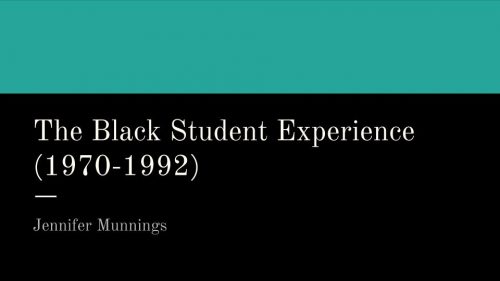 On March 16, 2018, five undergraduate students who have worked with the Race & Racism at the University of Richmond Project had the opportunity to present at the Lemon Project Symposium at the College of William and Mary. The panel, entitled “Seeing the Unseen and Telling the Untold: Institutions, Individuals, and Desegregating the University of Richmond,” was moderated by Dr. Nicole Maurantonio and featured Dominique Harrington, Madeleine Jordan-Lord, Elizabeth Mejía-Ricart, Jennifer Munnings, & Destiny Riley. Below you will find the text and slide images of Jennifer Munnings’s presentation, focusing on the research she conducted as a 2017 A&S Summer Research Fellow with the project. Click here to read more of her writing from last summer, and here to explore the exhibit she and her teammates created, “The Black Student Experience at UR (1970-1992).”
On March 16, 2018, five undergraduate students who have worked with the Race & Racism at the University of Richmond Project had the opportunity to present at the Lemon Project Symposium at the College of William and Mary. The panel, entitled “Seeing the Unseen and Telling the Untold: Institutions, Individuals, and Desegregating the University of Richmond,” was moderated by Dr. Nicole Maurantonio and featured Dominique Harrington, Madeleine Jordan-Lord, Elizabeth Mejía-Ricart, Jennifer Munnings, & Destiny Riley. Below you will find the text and slide images of Jennifer Munnings’s presentation, focusing on the research she conducted as a 2017 A&S Summer Research Fellow with the project. Click here to read more of her writing from last summer, and here to explore the exhibit she and her teammates created, “The Black Student Experience at UR (1970-1992).”
Jennifer Munnings is a rising junior at the University of Richmond double majoring in Sociology and Political Science with a minor in Women, Gender, and Sexuality Studies. She is from Nassau, Bahamas, and attended high school in New York. She was a research fellow during the Summer of 2017 for the University of Richmond Race & Racism Project where she created metadata for archival materials, wrote blog posts for the project, and collected oral histories and stories at the unveiling of the Maggie Lena Walker statue.

The University of Richmond was an institution actively involved in the fight for the Confederacy. In 1861 the main building of the University served as a hospital and later barracks and camping ground for Confederate soldiers and from around 1950 to 1970 the University’s unofficial mascot became the Confederate Spidy, a spider adorned in a Confederate army uniform. In 1954 after the Supreme Court case Brown v Board of Education was ruled and again post the Civil Rights Act of 1964 the University actively ignored calls for integration and formed a separate institution called University College away from the main campus for what they called in the “President’s Letter” the “non traditional” student where black students were allowed to attend after receiving threats of losing funding from the federal government. Although this is never explicitly stated it can be inferred that the new addition to the University conglomerate was used as a means to keep federal funding and limit bad publicity rather than to serve poor and minority communities. It wasn’t until 1968 that the University admitted its first black residential student, Barry Greene, to the main campus as Dominique [Harrington] stated earlier. Integration at Richmond was strenuous, to say the least, however, integration does not simply end with the presence of black students on campus. Rather, it extends to the quality of their experience as well.
My project was intended to find the good that often gets lost in stories of integration. It seeks to bring the black students to the forefront of their integration experience as individuals who sought to legitimize their time as students. The Black Student Experience at the Main Campus of UR, my Omeka Exhibit, examines students involvement as unintentional acts of activism and self-determination through the backdrop of university backlash and peer resistance.
The first wave of students was met with resistance on all levels from administrative, to faculty, to peers, black students on campus were treated as clear outsiders. The only other black people on campus would have been custodial staff or gardeners. When black students were brought onto campus, the quality of college experience they would receive outside of academics was clearly not taken into consideration by administrators. Black students were admitted, but none of the blatantly racist facets of the school were changed. For example, the playing of the Confederate anthem “Dixie” song at school games, to get that to change was a huge feet undertaken by both black and white students outlined in a 1971 Collegian article. There were no institutional supports, no clubs, and in many articles in our school’s newspaper archive black students said if they wanted any sort of social life they had to travel off campus. The school, although now admitting black students, was not at all trying to cater to them.
It is through the lens of unintentional acts of activism, resistance, and self-determination that the legitimization of the black student experience through the development of clubs, and organizations that cater to their experience are studied. The first club studied, the Student Organization of Black Awareness has some contestation on the actual start year of the club but it was sometime between 1972 and 1974. In 1973 William H. Leftwich, the then vice president of student affairs, wrote a memo to University President at the time E. Bruce Heilman and Charles E. Glassick about SOBA. In the memo, Leftwich introduces the purpose of the organization as “social in nature” but goes on to state that they were having some trouble as a result of “ lack of real purpose and goals”. SOBA’s President, Stanley Davis, and other members of the club had requested to meet with the University Administration to ask for their support and assistance. Leftwich asked Heilman and Glassick to attend SOBA’s meeting to show the university’s interest not only in the group but also in black students as a whole. However, attached to the letter was a handwritten note from Jim Sartain, the clubs advisor, about a two-and-a-half-hour meeting that he had had with SOBA and told Leftwich to be prepared for SOBA to request a “two-way informational meeting” with the University Administration. At the bottom of this handwritten note, however, the word “WARNING” is written in red. This memo highlights that the plight of black students was not seriously taken into consideration by university administrators and rather than using the meeting to be constructive and progressive, it was taken merely as symbolic way to show that the University supported black students. Despite a lack of support from the administration, however, this organization proved to be monumental in helping black students feel like they were apart of the University. SOBA was a social club intended to promote black visibility and integration into University of Richmond and as explicitly outlined in a Collegian article called “SOBA Moves Towards the Mainstream” published in 1974 was not intended to be a separatist group. Although the clubs primary focus was black students, it was open to all. SOBA organized the schools first Black History Week from February 3rd to 10th in 1974 which featured a rap session, a play performed by the Virginia Commonwealth University players, and a dance.
At University of Richmond social life has been dominated by Greek life. As a result, this worked to be a major exclusionary force. Although black students were allowed to join white Greek life, the atmosphere those organizations presented were not ones of inclusivity as illustrated in yearbook photos where Confederate flags are clearly displayed in Greek lodges, and other racist symbols like blackface are worn by members and people in attendance of parties. Black Greek life did not join the University of Richmond until 1980 with the first fraternity Phi Beta Sigma. Prior to this, there were 11 fraternities on campus, and only one black student was a part of it.
There were also many institutional blockages that prevented the chartering of black Greek life, one of the main ones being that there were simply not enough black students to charter chapters. In order for a new fraternity to create a chapter at University of Richmond, first a proposal had to have been approved by the Interfraternity Council (IFC) which are representatives of the 11 fraternities on campus, then the Student Life Council, a meeting of the faculty, and also of the Board of Trustees. The IFC had a unanimous vote to welcome the Sigmas to UR. Wayne Biggs, President of the IFC said in a Collegian article called “Largely Black Fraternity Seeks to Start UR Colony” that the fraternity would be “good for the University in terms of recruiting black students and good for black students in social terms.” Additionally, as the majority of black men on campus were football players at the time, it was hard for students to devote time to both football and Greek life.
The formation of Phi Beta Sigma and Delta Sigma Theta are also examples of activism and resistance as they faced some backlash from peers and administrators. The Collegian notes that the Committee on Sororities did not bring a historically black sorority to campus because they didn’t want to seem as though they were segregating black and white students, or that the administration did not want black students with white students. The historically black fraternity Phi Beta Sigma would have already been established at that point which highlights a little bit of inconsistency. The Dean of Westhampton College, Patricia C. Harwood said, “It seems that minority students need and benefit from an opportunity not only to be a part of the integrated mainstream of life on the campus but also from an opportunity to come together in an organization of minority students.” Black Greek organizations helped to create ways for black students to get involved on campus through community service projects to the greater Richmond area.
The purpose of my exhibit was to bring some agency back to these black students, that the first wave of black students to the University of Richmond were not victims of segregation but rather chose to rise above their situation and instead make the campus a place that black students can find a home. Despite the constant backlash that they received these organizations and the people that created them were true activists, validating black voices and demanding that their presence be acknowledged and respected.
Today, SOBA and Phi Beta Sigma are no longer represented on campus. However we now have the Black Student Alliance, and historically black fraternities Alpha Phi Alpha and sorority, Alpha Kappa Alpha. These organizations continue to do the work of the ones that came before them in legitimizing black students. Although there is still work to be done, it is thanks to the organizations and the people that founded them that we are here today. Thank you for listening.
